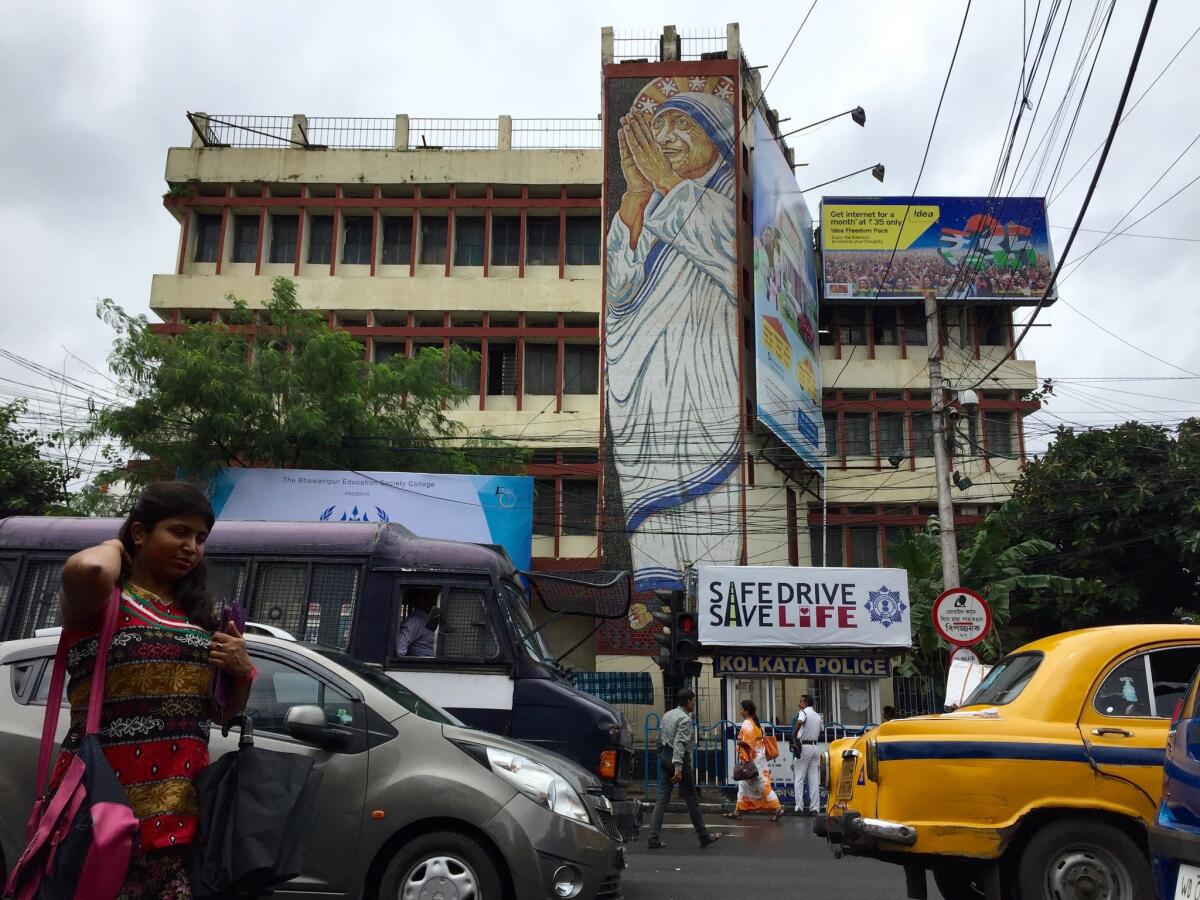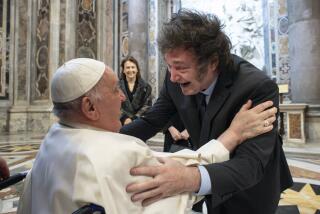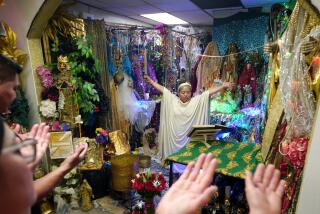Was Mother Teresa a saint? In city she made synonymous with suffering, a renewed debate over her legacy

Reporting from Kolkata, India — Few people are as closely identified with a city as Mother Teresa is with Kolkata, the onetime colonial Indian capital where the Albanian nun garnered worldwide admiration for her work with the poor, infirm and outcast.
As the Catholic Church prepares to canonize her as a saint, the city formerly known as Calcutta is poised for a rare moment in the spotlight.
But not everyone is celebrating.
“She had no significant impact on the poor of this city,” said Bikash Ranjan Bhattacharya, who served as mayor from 2005 to 2010.
She was responsible for creating a negative image of this city.
— Bikash Ranjan Bhattacharya
“Whatever good work she did has also been done by any other philanthropic organization. I don’t find anything extraordinary in it.”
Bhattacharya is one of a few vocal critics in Kolkata who argue that Mother Teresa’s shelters glorified the ill rather than treating them, and that her charity appeals across the world misstated the reality of what was once among India’s most prosperous cities.
“No doubt there was poverty in Calcutta, but it was never a city of lepers and beggars, as Mother Teresa presented it,” Bhattacharya said.
“She was responsible for creating a negative image of this city. As a Calcuttan I feel totally disgusted by it.”
Pope Francis’ canonization of Mother Teresa in a ceremony at the Vatican on Sunday has renewed a debate over her legacy in the city she made synonymous with suffering and sacrifice.
Many in Kolkata revere her for the half-century of service that earned her a Nobel Peace Prize and the moniker “saint of the gutters.” The Missionaries of Charity, the order she founded in 1950, sheltered tens of thousands of leprosy victims, sidewalk-dwellers, tuberculosis patients, orphans and the disabled at 19 homes across the city, and now has branches in 150 countries.
Until her death in 1997 at age 87, she was the Indian government’s favorite adopted citizen, honored with its highest civilian award, the Bharat Ratna, in 1980.
Even as Hindu nationalist groups rose to prominence and opposed the expansion of Christian missionary organizations, Mother Teresa was usually accommodated. She opened her first shelter — Nirmal Hriday, or Pure Heart, a “home for the dying” — in an abandoned temple next to Kolkata’s most revered Hindu shrine.
“It is a great blessing that Calcutta is associated with Mother Teresa,” said Sunita Kumar, an artist and socialite who befriended her and served as an unofficial spokeswoman.
In a city of 5 million that gave India some of its greatest writers and artists, including Nobel laureate Rabindranath Tagore, it is Mother Teresa’s name and visage — swathed in her familiar white sari with blue stripes — that are most prominent.
Park Street, the city’s main commercial thoroughfare, was renamed for her. Mother House, the gray-washed hostel for nuns where she lived and is now entombed, draws tourists from around the world. Volunteers of all ages flock to her charity homes.
In the narrow lanes around the Nirmal Hriday house in Kalighat, where colonial-era buildings gently decay in the sticky heat, residents and saffron-clad Hindu priests recalled Mother Teresa — although weakened by a heart ailment in her later years — as an indomitable presence.
“She would walk through the streets or go around in a wheelchair, speaking with everyone,” said Renu Sarnakar, a bespectacled woman in her 50s who was fashioning packets of Hindu religious offerings out of banana leaves. “Once she caressed my face very lovingly, even though I was ill.”
A widow, Sarnakar said she was admitted to Nirmal Hriday a decade ago with tuberculosis. Medical care was basic, and Sarnakar recalled that many in the women’s ward did not survive.
“The ones who die, they die,” Sarnakar said. “But for those who can get better, the sisters are very good to us.”
Mother Teresa faced criticism over the spartan conditions at Nirmal Hriday beginning in the early 1990s. The editor of the Lancet medical journal, Robin Fox, found after volunteering there that the sisters did not seek medical diagnoses for patients and administered only the most rudimentary painkillers and antibiotics.
The nuns resisted change, with Mother Teresa often saying that suffering brought one closer to God. A decade after her death, the nun then in charge of the home, Sister Glenda, told the local Telegraph newspaper, “We don’t want modern things.”
In the fall of 2008, Hemley Gonzalez, a Cuban-born Miami real estate broker seeking a fresh start after the housing crash, came to Nirmal Hriday as a volunteer. He was tasked with giving daily sponge baths to 50 men, including some suffering from respiratory infections.
But there was no heating, making the water unbearably cold for the patients, Gonzalez said.
“The men started screaming when I poured water on them,” he said. “I’m not a doctor, I’m not a nurse, but I can tell by common sense that if someone has a respiratory disease you don’t bathe them with cold water.”
When Gonzalez proposed raising money for a water heater, senior nuns rebuffed him.
Gonzalez said the nuns did not distinguish between patients who were terminally ill and those who could be treated and released. He said he observed nuns rinsing dirty needles with tap water and reusing them.
“It felt like a museum of poverty,” said Gonzalez, 40, who later founded Responsible Charity, a nonprofit organization that promotes children’s education in Kolkata and the western city of Pune.
See the most-read stories in World News this hour »
Today, the bathrooms and water systems have been improved, and needles are sterilized. Still the house remains spare. Inside the men’s ward, two dozen slender cots are lined up side by side under ceiling fans. One morning recently, a European volunteer filled a pail to wash the misshapen arms of a crippled man, who howled when the sponge grazed a sore on his palm.
Kumar said Mother Teresa gave “dignity in death” to thousands who would have perished on the streets and dismissed criticism that the millions she raised were nowhere to be seen in Kolkata.
“No one can accuse the Missionaries of Charity of mishandling funds,” Kumar said.
Aroup Chatterjee, a Kolkata-born physician, said when he moved to Britain to practice medicine in the mid-1980s, Westerners told him constantly that his city “must be horrible, because that’s where Mother Teresa works.”
While Kolkata has vast pockets of poverty — three in 10 residents live in slums — it has lower income inequality and fewer underage workers than other major cities, according to official statistics, and the state’s per capita income is on par with the national average.
“It was very disturbing for me to hear that people thought that I came from a city and a culture that was so helpless that we couldn’t take care of ourselves, and we had to depend on an Albanian nun to look after our every need,” Chatterjee said.
A former volunteer at one of her charitable homes, Chatterjee has spoken out against Mother Teresa for more than two decades. His research helped form the basis for “Hell’s Angel,” a 1994 documentary hosted by British author Christopher Hitchens that was the first major critique of Mother Teresa to appear in the mainstream Western media.
In a 400-page book, recently rereleased under the title “Mother Teresa: The Untold Story,” Chatterjee levels an extensive list of complaints — including her embrace of unsavory donors (including savings and loan swindler Charles Keating) and allegations that she secretly converted Hindu and Muslim patients to Christianity on their deathbeds.
In a videotaped January 1992 meeting with the staff at Scripps Clinic in San Diego, where she had been treated for pneumonia, she boasted of baptizing as many as 29,000 people who had died at Nirmal Hriday since 1952.
“Not one has died without receiving the special ‘ticket for St. Peter,’ we call it,” she said. “It is so beautiful to see the people die with so much joy.”
Chatterjee said Indian officials should have raised concerns that the conversions violated the patients’ religious freedom, but such views remain unpopular. Last year, a prominent Hindu leader drew nationwide outrage when he alleged that conversion was Mother Teresa’s main motive.
“People are afraid to come out against such a Western icon,” Chatterjee said on a visit to Kolkata. “India is still a colonized nation in its mind.”
Mother Teresa’s path to sainthood was fast-tracked the year after she died by the then-pope, John Paul II. In December, she cleared the last hurdle when Pope Francis recognized a second miracle attributed to her — the recovery of a Brazilian man who suffered from brain tumors.
The first miracle was recognized in 2003 after a tribal Indian woman, Monica Besra, said a medallion with Mother Teresa’s image cured her cancerous tumor. Besra’s doctor challenged that claim, saying the tumor was actually a cyst due to tuberculosis, and treated with medication.
Debasis Bhattacharya, Kolkata-based director of the Science and Rationalists’ Assn. of India, a group that advocates for scientific thinking, said the miracle claim would encourage others to seek dubious cures from gurus and faith healers.
Bhattacharya, who is no relation to the former mayor, said that despite the money and attention lavished on the Missionaries of Charity, their work has not dented the city’s poverty.
“I don’t think there’s been any big change in Calcutta due to Mother Teresa,” Bhattacharya said. “It would have been the same with or without her.”
Follow @SBengali on Twitter for more news from South Asia
ALSO
In India, a journalistic expose leads to a criminal complaint — against the journalists
Meet the Nightcrawlers of Manila: A night on the front lines of the Philippines’ war on drugs
More to Read
Sign up for Essential California
The most important California stories and recommendations in your inbox every morning.
You may occasionally receive promotional content from the Los Angeles Times.











